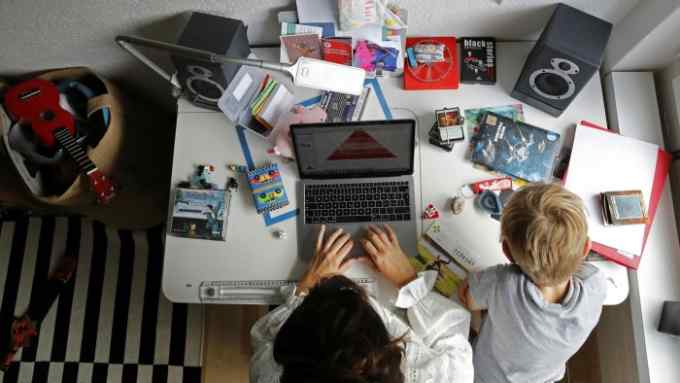‘Hybrid’ working calls for patience and ingenuity

Roula Khalaf, Editor of the FT, selects her favourite stories in this weekly newsletter.
“Human beings were not meant to sit in little cubicles staring at computer screens all day,” complains Peter, a character in the cult workplace comedy Office Space. That film came out in 1999. By the beginning of 2020, most real-life equivalents of Peter’s imaginary employer Initech were still asking workers to perform their tasks in a similar way in the same sorts of places.
The pandemic and subsequent lockdowns shook the status quo. One possible vision of the future of work suddenly seemed much closer after staff were ordered to quit the office and work remotely. Surveys suggest most of them would prefer to continue to work at least part of the week from home. Some organisations, including technology companies, banks, and professional services firms, have taken steps to accommodate more remote working even after the crisis lifts.
According to the McKinsey Global Institute, though, even in the UK only 33 per cent of tasks could be handled outside the workplace without some loss of productivity, a figure that falls to 12 per cent in India. The crisis has also challenged assumptions about what sort of labour is deemed essential — including many tasks, from delivery courier to nurse, that could not easily be carried out from a cubicle — and how to value and organise it.
“Hybrid” will be the word of the year in 2021, then, as managers struggle to find a balance between remote workers and those who, by choice or necessity, cannot work from home.
Ensuring these groups can co-ordinate and communicate efficiently will be hard enough. A spontaneous brainstorm loses its spark if the space in which to host it has to be booked weeks in advance. Videoconferences falter when some participants are in the same room and others are on screen.
The bigger challenge, requiring patience and experimentation, will be shaping fulfilling roles and arranging projects so they can be performed efficiently by a widely distributed workforce. Employers have realised far more work can be done at a distance than they previously believed, but that imposes its own strains.
Most white-collar workers still spend their days staring at computer monitors, whether at home or in the office. Unilever is testing a four-day week for its New Zealand staff, which may be just as productive but less stressful than the traditional five-day stretch. Companies such as Facebook have advertised for a “director of remote work” to handle the coming change.
Some employers will simply outsource remote work to eager contractors in a lower cost location or hand it to uncomplaining machines. The acceleration of workplace automation as a result of the pandemic is already putting jobs in hard-hit sectors of the UK such as retail and hospitality in jeopardy, according to a recent report by the trade union Community and the Fabian Society, a think-tank. Workers cannot, though, easily shift to areas of greater demand, such as social care or cyber security. A concerted effort is needed to train them in new skills and to design the jobs of the future so they are not just better paid, but more fulfilling.
Companies are still bound to expensive real estate and to the less visible, but no less rigid hierarchies of pre-pandemic jobs. The crisis should have taught them, though, that work can be done in more fluid and flexible ways than they imagined, with more responsibility delegated to front-line teams. There is no need to burn down the office, as one cubicle-dweller does at the end of Office Space. But this is not the moment, either, for employers to put all staff, always, back into their boxes.

Comments